Lunch Hour Fitness
Get a Full Workout in 60 Minutes!
Kids, work, and responsibilities. They eat away at our days and leave
us strapped for time. Sometimes it seems that the only second we get to
ourselves is our lunch hour, and all we want to do during that brief window of
time is just sit in peace and quiet. But what if, instead of giving that hour
over to another mindless task (even if it has nothing to do with work), you re-energized
yourself with a lunchtime workout? With a little bit of planning and determination to
keep at it, you might find that you look forward to that hour of working physically hard
in the midst of your mentally challenging day more than you would look forward to an hour
of reading gossip sites. Not only that, but by getting up and moving around, you will
combat the health issues associated with sitting too much, fight obesity, and decrease
your risk of heart disease. Sounds like a winning proposition!
The major obstacle to the lunch-hour workout is the old enemy – time. How can you
prepare for a workout, get the blood pumping, cool down, get dressed, and be back at
your desk in the traditional one-hour lunch break we’ve become accustomed to? It takes
some planning, and we’ve got that plan laid out for you!
The Night Before
Make a plan for your workout the next day and pack your bag:
- Sports bra and shirt
- Underwear and shorts
- Socks and shoes
- Lunch for afterward (since you likely won’t have time to grab any during)
- Plastic shopping bag for sweaty clothes and/or shoes
- If you have extra room at work, you might keep a spare pair of socks, underwear, and even workout gear in case you forget something!
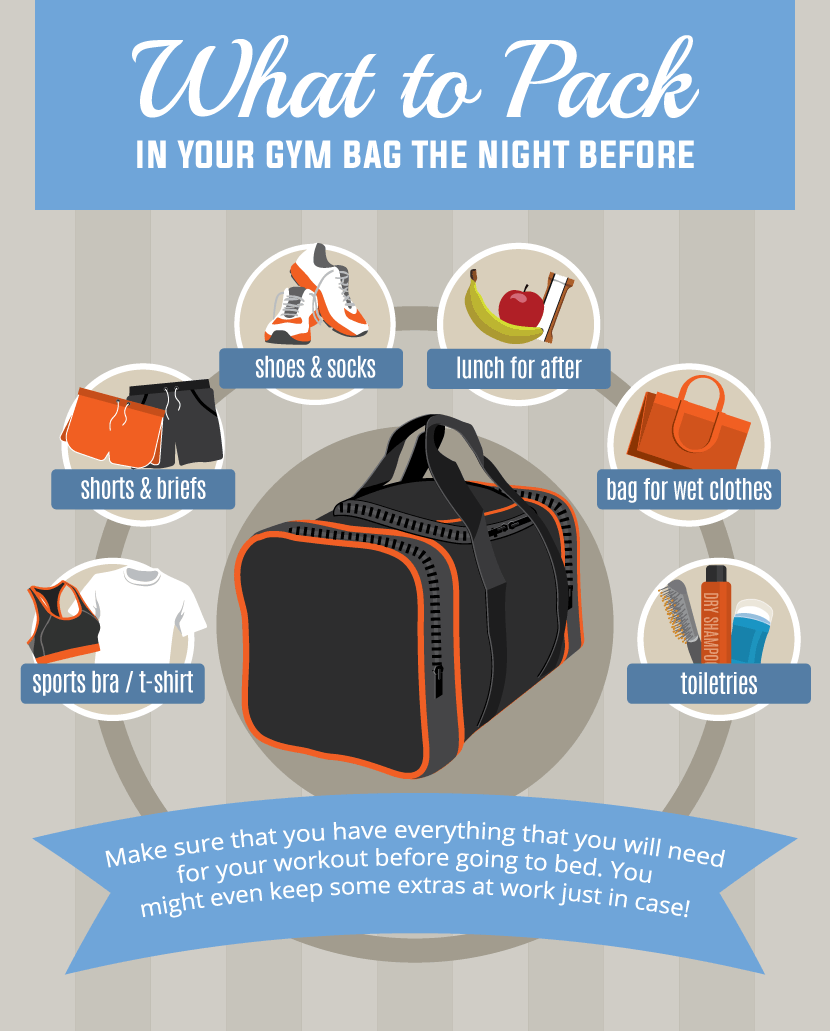
Morning Of
Try to eat about three to four hours before
(four if you can plan on having access to a snack). But make certain
that you eat breakfast and that your breakfast is balanced with protein,
fiber, fats, and carbs.
Some great ideas:
- Plain oatmeal (can be gluten free!) prepped with water or unsweetened
almond milk, stevia, a little bit of salt, cinnamon, and peanut butter.
You can make this the morning of or prep it the night before (search for
“overnight oats” recipes!).
- Whole wheat English muffin with the same toppings and some crushed
fresh berries rather than jam.
- Want a non-bread carb option? What about sweet potato?
- For protein, Greek yogurt would be a great choice!
Important note: Buy everything unflavored or unsweetened at the store so that you
can adjust the sweetness yourself and avoid a sugar crash. If you like bananas, save
them for snacks!
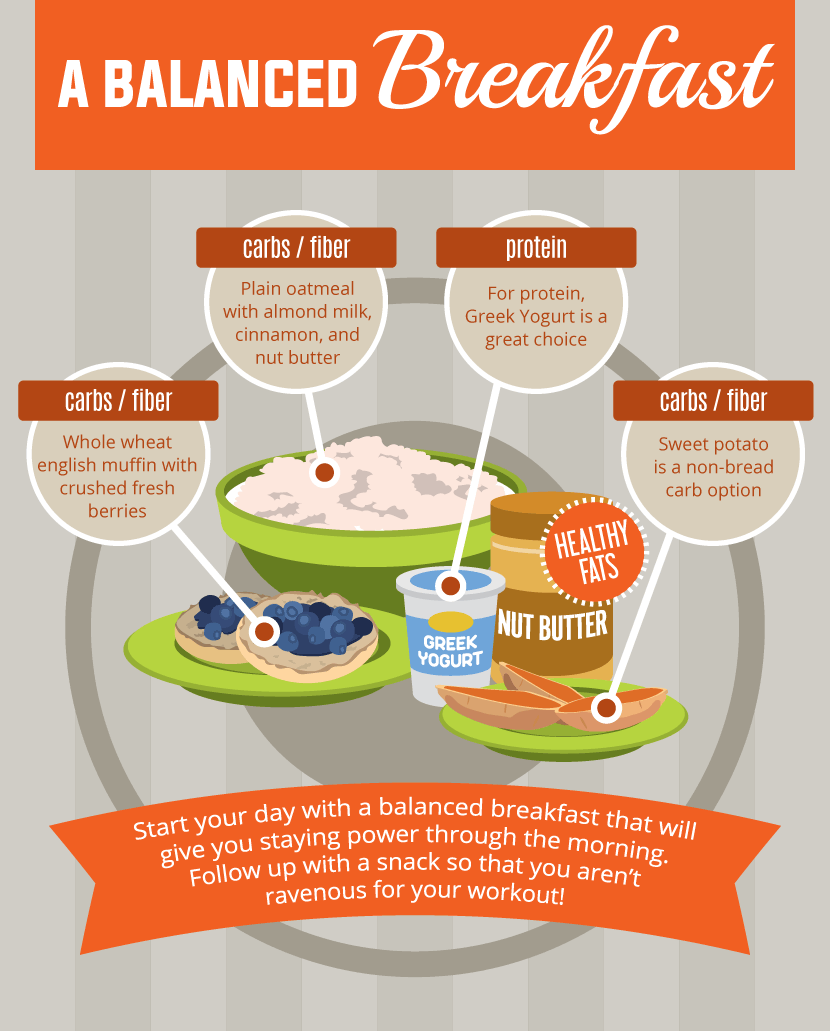
30-45 Minutes Before
Prep for your lunch workout by having a small snack, such as plain cereal, an apple,
or banana with a glass of water (you really only need about 100 calories of easily
digestible carbohydrates). This will help you get through your workout without that
annoying stomach growl or feeling hangry (angry because of hunger) but without causing
digestive distress.
15-30 Minutes Before
Start to stretch and move around. Get up for walking breaks. Roll your
ankles/feet around. Shrug your shoulders and move your head around gently.
Start to get the blood flowing!
Time to Work Out
Change as quickly as you can and get ready to leave your workday behind for hour!
“Runch”
Running + Lunch = Runch! Runch is a great strategy for those who have tight schedules
or schedules that make for very busy mornings or afternoons, like parents. Runch is also
a great idea during the winter, when the sun rises late, sets early, and the conditions
might even be dangerous for running in the morning because of ice or freezing temperatures.
Prep for your runch to avoid injury. Definitely make sure to get up and moving before
you leave to change, and pay special attention to your warmup. Do not static stretch muscles
that are stiff from sitting; rather, move around in different directions prior to getting on
the treadmill or heading outside.
Walk for at least five minutes at a rather brisk pace (on an incline on the treadmill)
to start to engage your gluteus and leg muscles, and swing your arms to get your upper body
involved as well. Then move up to a slower run (a pace about 30 seconds per mile slower than
your usual running pace). Try to keep the treadmill on at least a one percent incline to mimic
outdoor running and to keep your glutes engaged.
After the first half to full mile, pick up the pace and go run! Some great running
workouts are progressive runs (increasing the pace over the course of the run), intervals
(running faster for short periods with a rest in between), hill work (increasing the incline),
or just enjoying your time. Give yourself at least two to three minutes of walking at the end
to bring your heart rate down. To make the most of your time, stretch as you are getting
yourself put back together or even while eating lunch!
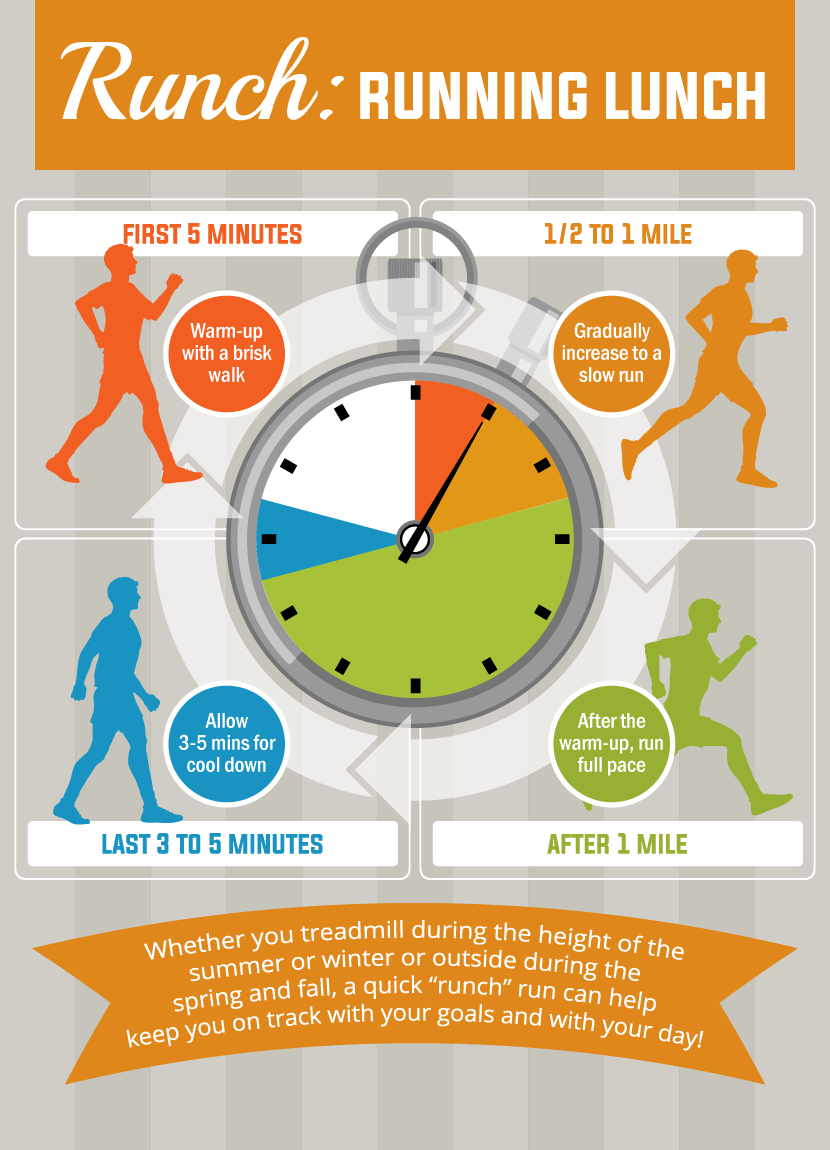
Circuit Training
If you only have about 30-40 minutes for the actual workout, circuit training
is another great option.
Start with a warmup of at least five minutes of cardio
activity and then work through two to three circuits of exercises that
include an upper-body strength move, lower-body strength move, cardio
interval, and core strengthener, and cycle through. An example:
- Upper body: 12 Arnolds (bicep curl to shoulder press), full push ups, triceps dips off bench
- Lower body: 20 glute bridges with feet on a Bosu Ball, goblet squats, walking lunges
- 30 seconds of high knees, frog jumps, or burpees
- 20 Supermans, bicycle crunches, or 30-second to 1-minute planks
- Repeat circuit three times before moving to the next circuit
These circuits can also be broken down into strength circuits (also called supersets) and
cardio plus core circuits. Aim for compound moves or moves that hit multiple systems of
the body. Of course, you should only use equipment that you have a proper working knowledge of!
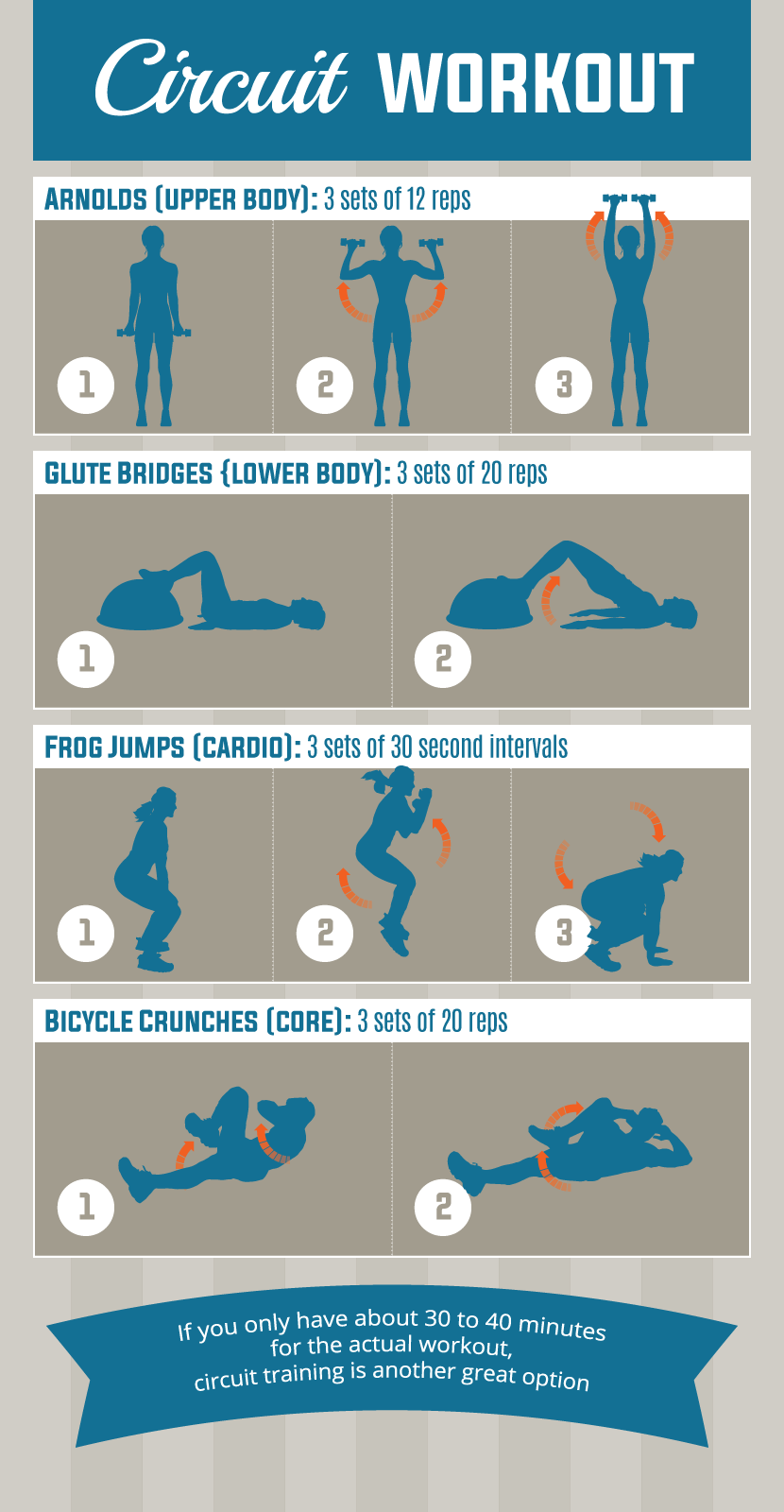
Body Split Strength Training
If you have knowledge of a weight room, you can always work through body split days;
the shortened amount of time is perfect for focusing on a particular muscular system such
as the shoulders, back, chest, triceps, biceps, legs, glutes, and stabilizers.
Regardless of what you decide on, make sure to warm up your body by including an
extra circuit of exercises at lighter weights mixed with some stretching and
recirculation of the blood in your limbs. Try to get your heart rate back up in
between your movements by incorporating cardio bursts. This will help keep you
warm (and therefore help to avoid injury) as well as help to burn extra calories.
Other great ideas? Grab some workmates and set up a workout room! Bring in a DVD
player or laptop and set up a Pilates, yoga, or bootcamp video. Take turns bringing
in different videos so that you can try various workouts. Many workout DVDs and online
videos are excellent for getting in a 30-minute workout! This is also a very helpful
option in an office with a spare room that can be turned into a mini workout room and
makes getting back to the desk within the hour a much easier task.
After your workout, it is time to get refreshed and ready to get back to work!
Things to consider keeping at the office (if space permits):
- Hairbrush and hair ties
- Towel (if you don’t have the space, bring one with you)
- Dry shampoo
- Travel-sized shampoo, conditioner, and body wash
- Face and body cleansing wipes
- Perfume (if you wear it) and makeup basics
- Deodorant
- Lotion
- Flip flops
- Energy bar
If you are truly sweaty, jump in for a quick shower, but you might find that you
only need to use some dry shampoo and a blitz under a hair dryer. Use face and body
cleansing wipes to refresh your skin and get rid of any odor, and then finish with
deodorant, lotion, makeup, and perfume (but don’t overdo this; you don’t need to mix
too many smells!). Use the plastic bag that you brought for your sweaty clothes, and
return to your desk ready for lunch!
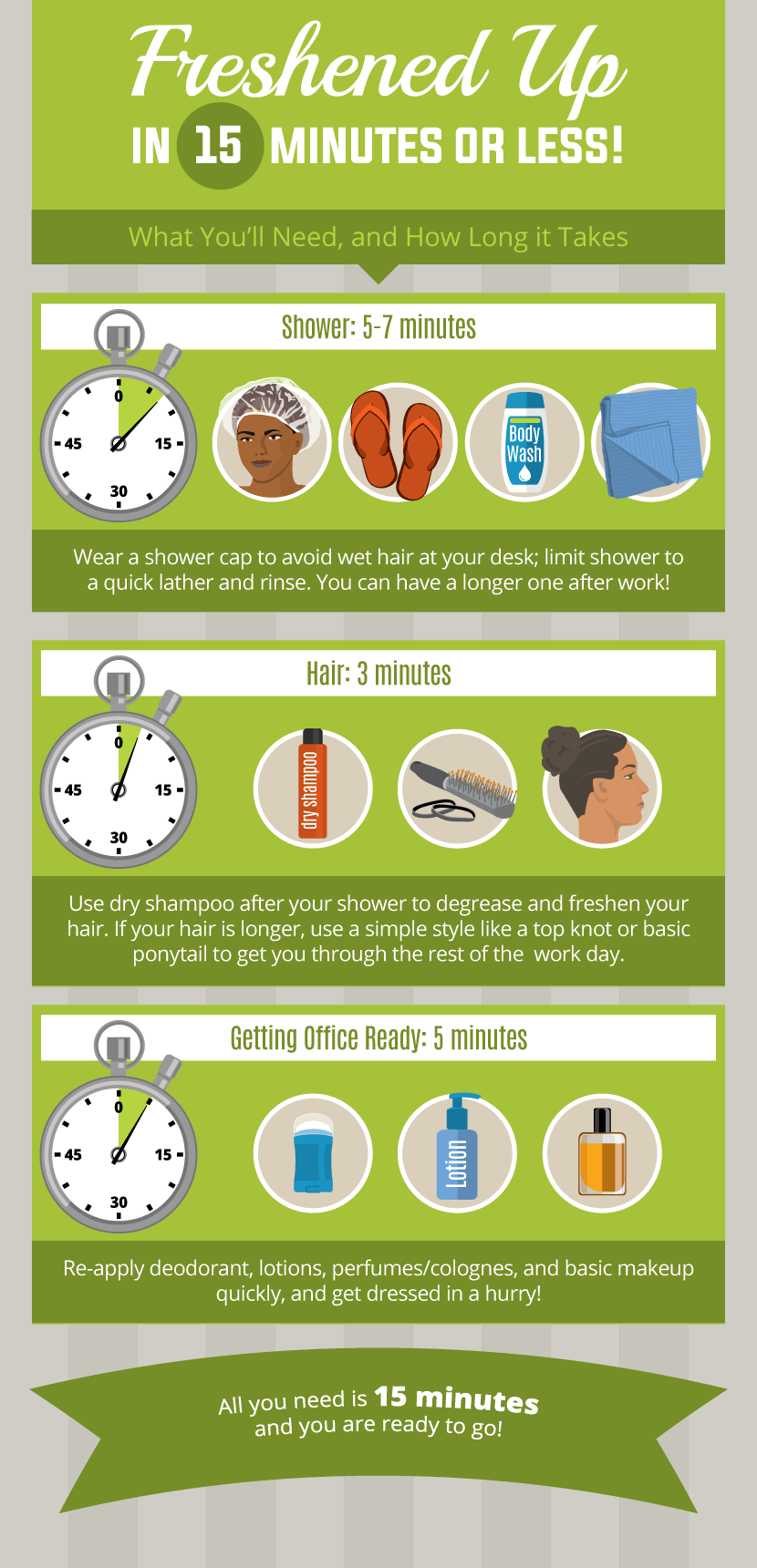
Eating After
Don’t think for a second about skipping lunch, either! This is perhaps the most important time for you to eat – during the
recovery window. You might not be hungry, or you might be starving. Regardless, have a glass of water and a well-balanced
lunch with veggies, protein, carbs, and healthy fats. The combination of these essential nutrients will aid in your recovery,
muscle repair, and growth and help you stay satiated. Avoid lots of heavy dressings and grease – you worked out; you didn’t
run a marathon!
If you really aren’t feeling so hungry, aim for 200-300 calories with a good nutrient ratio in another form, such
as a meal bar or smoothie. There are some great natural, lower-sugar energy bars with decent protein and carb ratios.
Aim for bars with more grams of protein than sugar, and avoid bars with more than 10 grams of fiber or 20 grams of protein.
Not only will those be very difficult for your body to digest, but 20 grams of protein is the optimal amount for protein synthesis at any given time.
Be careful of smoothies. The majority of mass-market options are packed with sugars and processed crap, for
lack of a better word. Make your own with half a banana, a scoop of protein powder, spinach, a quarter avocado,
and unsweetened almond milk. You can even add some oats! Add some other fruit for flavor and perhaps a bit of
stevia. Blend and store in the fridge at work. If you can, bring in a small personal blender! Then just add ice and pulse away.
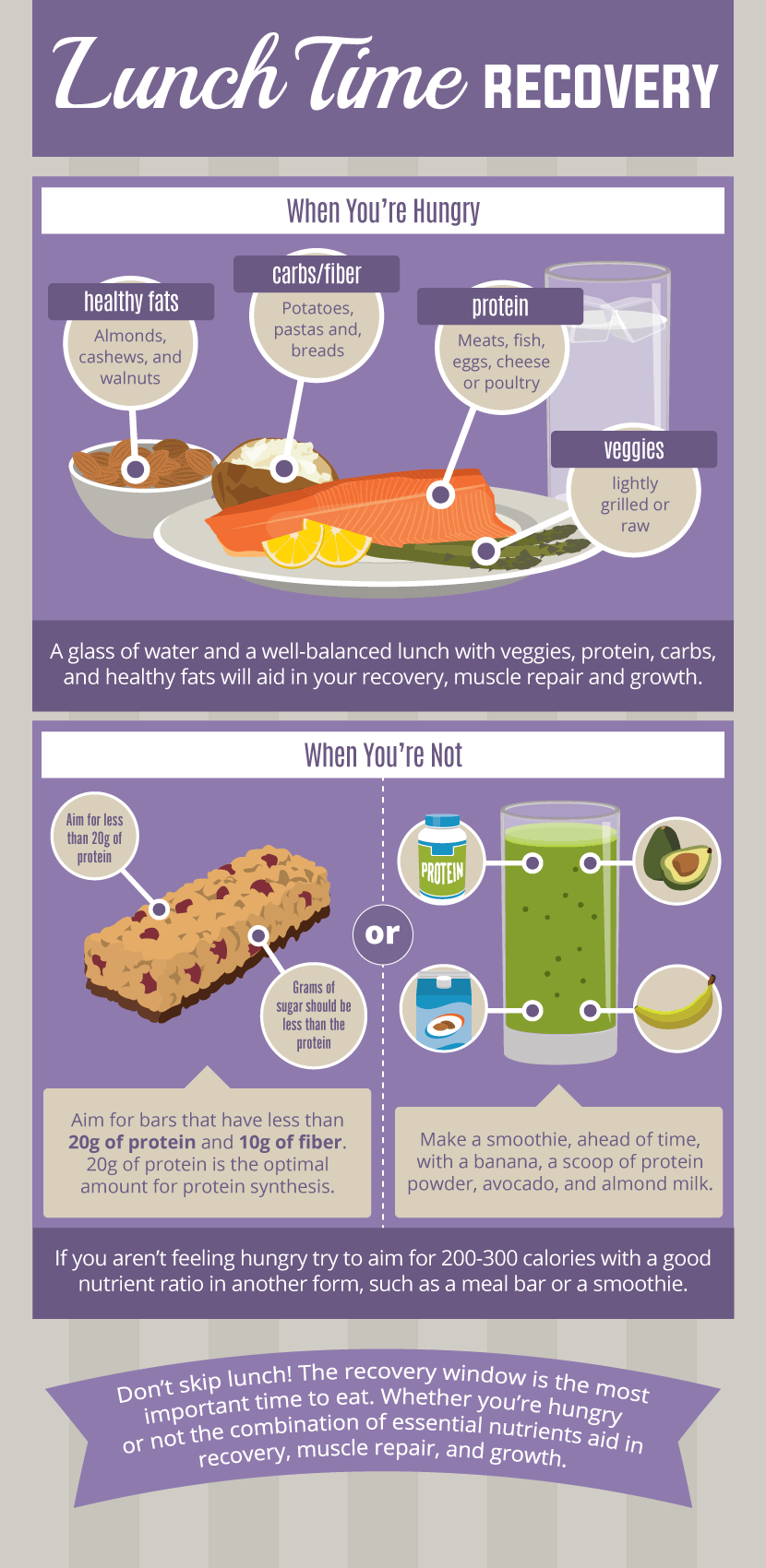
Take back an hour of your work day for you by grabbing a workout. Chances are you will find that you are in a better mood
and better able to focus for the rest of the day, particularly after you finish up by refueling. And don’t let the activity
end there! Try to get up throughout the day and walk around, even for only two minutes at a time! Drink water throughout the
day as well. Who knows – by taking time to stop what you are doing, you might find that you accomplish more than ever before!
Embed the article on your site

